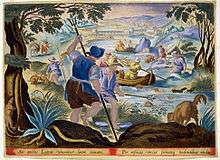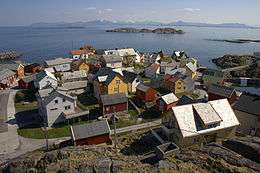Clovelly
Clovelly (/kləˈvɛli/) is a harbour village in the Torridge district of Devon, England. Its steep pedestrianised cobbled main street, donkeys and views over the Bristol Channel attract numerous tourists. At the 2011 census, the parish population was 443, which was 50 fewer than ten years previously.[n 1][1] The ward of Clovelly Bay includes the island of Lundy.[2]
| Clovelly | |
|---|---|
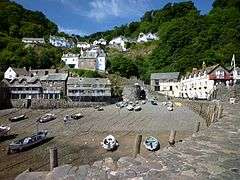 Lower part of the village, from the harbour wall | |
 Clovelly Location within Devon | |
| Population | 443 - Whole parish (2011) |
| OS grid reference | SS315245 |
| District | |
| Shire county | |
| Region | |
| Country | England |
| Sovereign state | United Kingdom |
| Post town | BIDEFORD |
| Postcode district | EX39 |
| Dialling code | 01237 |
| Police | Devon and Cornwall |
| Fire | Devon and Somerset |
| Ambulance | South Western |
| UK Parliament | |
There is a village visitor centre which charges a fee for parking, entrance to two museums, Clovelly Court gardens, and an audiovisual guide to the village's history.[3]
History
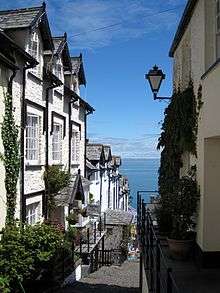
Northwest of the village is the site of the Iron Age hillfort at Windbury Head. Clovelly used to be a fishing village and in 1901 had a population of 621. It is a cluster of largely wattle and daub cottages on the sides of a rocky cleft; its steep main street descends 400 feet (120 m) to the pier, too steeply to allow wheeled traffic. Sledges are used for the movement of goods.
All Saints' Church, restored in 1866, is late Norman.[4] In the reign of King Richard II, the Manor of Clovelly was bought by the judge Sir John Cary (died 1395) and the church contains several monuments to the Cary family, Lords of the Manor for 600 years.
Unusually, the village is still privately owned and has been associated with only three families since the middle of the 13th century, nearly 800 years. The estate is run by the Clovelly Estate Company, led by the Hon. John Rous, a descendant of the Hamlyn family who have owned the village, estate and manor house Clovelly Court since 1738. John Rous is the eldest son of Keith Rous, the 5th Earl of Stradbroke and Mary Asquith, granddaughter of former Prime Minister H. H. Asquith, 1st Earl of Oxford and Asquith.[5]
The scenery has been captured by artists for its richness of colour, especially in the separately accessed and separated Clovelly Court and along The Hobby, a road cut through the woods and overlooking the sea. The South West Coast Path National Trail runs from the top of the village and the section from Clovelly to Hartland Quay is particularly spectacular.
Buildings
Each of the buildings along the terraced cobbled street is architecturally listed: more than 50 of these 71 are on the main street itself. Only seven buildings are not listed. At Grade II*, are numbers 16, and 45-47, 53-54, (53 has the house name Crazy Kate's) and 59-61.[6] There are two public houses and two hotels.
Lifeboat station
The village has an RNLI lifeboat station with its boat the Toby Rundle installed in 2014.[7][8]
Access
There is a public road leading to the harbour and main street with a right of way for pedestrians and vehicles. The village main street is not accessible by some motor vehicle.[9][10]
The lack of vehicular access to the main street has led to deliveries being made by sledge.[9] This is not done as a tourist attraction, but as a matter of practicality. Goods are delivered by being pulled down on a sledge from the upper car park, and refuse is collected by being pulled down the hill to a vehicle at the harbour.

The village is served by Stagecoach bus service 319; the route includes Barnstaple, Bideford and Hartland.[5]
Notable residents and cultural references
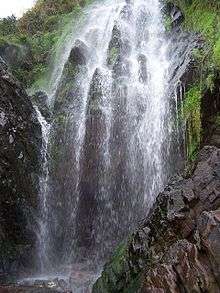
The novelist Charles Kingsley lived here as a child from 1831 to 1836, while his father, Rev. Charles Kingsley served first as senior curate then as rector. Later, in 1855, his novel Westward Ho! did much to stimulate interest in Clovelly and to boost its tourist trade.
Actor Joss Ackland and his wife Rosemary bought a property in Higher Clovelly on the outskirts of the village in 1989.[11] Ackland still lives there but Rosemary died in 2002 and is buried in the grounds of their home.[12] Ackland has appeared in promotional videos for the town and has spoken often of his love of and connection to Clovelly.[13]
Clovelly is also described by Charles Dickens in "A Message from the Sea"[4] and was painted by Rex Whistler, whose cameos of the village were used on a china service by Wedgwood.
The sixteenth-century Carys of Clovelly feature in the historical novel The Grove of Eagles by Winston Graham.
The surgeon Campbell De Morgan (1811–1876), who first speculated that cancer arose locally and then spread more widely in the body, was born here.
Clovelly is mentioned in passing by Rudyard Kipling in Stalky & Co. as being located to the west of the boys' academy.
In Susan Coolidge's In the High Valley (1890), part of the Katy series, a walk into Clovelly is described: "... surely a more extraordinary thing in the way of a street does not exist in the known world. The little village is built on the sides of a crack in a tremendous cliff; the "street" is merely the bottom of the crack, into which the ingenuity of man has fitted a few stones, set slant-wise, with intersecting ridges on which the foot can catch as it goes slipping hopelessly down." [14]
J. M. W. Turner's painting of Clovelly harbour around 1822 hangs in the National Gallery of Ireland, Dublin.[15]
On Sunday 28 October 1838 twelve fishing vessels with a total of twenty-six men on board left Clovelly harbour for the fishing grounds. Only one vessel and its crew ever returned after a ferocious storm in the Bristol Channel. This event led to the founding of the Shipwrecked Mariners’ Society early the following year with the object of:
giving relief and assistance to the widows and orphans of fishermen; and of mariners, members of the Society, who lose their lives by storms and shipwreck on any part of the coasts of the United Kingdom, while engaged in their lawful occupations; and also to render necessary assistance to such mariners, soldiers, or other poor persons as suffer shipwreck upon the said coasts.
The charity is active supporting the seafaring community suffering hardship and distress.[16]
Cultural tradition
An 18th-century chapbook entitled The History of John Gregg and his Family of Robbers and Murderers explains that "Chovaley" (i.e. Clovelly) was once the home of a tribe of cannibalistic bandits. It is alleged that Gregg and his extended family of dozens were eventually tracked down by bloodhounds and were burnt alive in three fires. They were said to have lived in "a cave near the sea-side" and had committed some 1,000 murders.[17] Although the story is fiction, writer Daniel Codd observes that a stretch of Clovelly Bay is called "the Devil's Kitchen"—"an apt name indeed if there is any truth in the ghoulish story of the Gregg family".[18]
See also
Notes and references

Notes
- The ward of Clovelly Bay, which includes a neighbouring civil parish, had a total population in 2011 of 1,627, 11 greater than in 2001
References
- Key figures for Clovelly Bay Office for National Statistics Retrieved 2008-10-20
- Ordnance Survey Election Maps
- "Visiting Clovelly - Clovelly". www.clovelly.co.uk. Retrieved 24 May 2019.
- Chisholm, Hugh, ed. (1911). . Encyclopædia Britannica. 6 (11th ed.). Cambridge University Press. p. 561.
- http://www.clovelly.co.uk Visitors' Website
- 16 Historic England. "Details from listed building database (1104517)". National Heritage List for England. Retrieved 30 March 2013.
45-47 Historic England. "Details from listed building database (1104522)". National Heritage List for England. Retrieved 30 March 2013.
53-54 Historic England. "Details from listed building database (1333120)". National Heritage List for England. Retrieved 30 March 2013.
59-61 Historic England. "Details from listed building database (1333138)". National Heritage List for England. Retrieved 30 March 2013. - "Grief of lost son sparks cash aim for new lifeboat project". North Devon Journal. Retrieved 27 December 2015.
- "Clovelly Lifeboat Station welcomed latest boat, named after man who died in 2009". North Devon Journal. Retrieved 27 December 2015.
- "Clovelly". Devon Online. Archived from the original on 17 August 2016. Retrieved 18 July 2016.
- Ordnance Survey (2019). Explorer Sheet 126 (Map). 1:25,000. Explorer. Ordnance Survey.
- "INTERVIEW: Joss Ackland on King Lear and his Clovelly roots". North Devon Journal. Retrieved 27 December 2015.
- Kate Bohdanowicz. "Motor neurone disease made Joss Ackland and his wife live life to the full". Express.co.uk. Retrieved 27 December 2015.
- One Foot in the Past - Joss Ackland - Clovelly. 4 January 2010. Retrieved 27 December 2015 – via YouTube.
- "In the High Valley by Susan Coolidge". Project Gutenberg. Retrieved 27 December 2015.
- "Joseph Mallord William Turner". Tate. Retrieved 18 July 2016.
- "Home page". 27 December 2015. Retrieved 27 December 2015.
- James Halliwell-Phillipps (July 1849). Notices of Fugitive Tracts, and Chap-books. Read Books (2013). p.85. ISBN 978-1473309128
- Codd, Daniel (2013). Paranormal Devon. Amberley. p.126. ISBN 978-1848681668
Further reading
- Sheila Ellis, Down a Cobbled Street: The Story of Clovelly, 1987
- Charles Kingsley, Westward Ho!, 1855
External links
| Wikimedia Commons has media related to Clovelly. |
| Wikivoyage has a travel guide for Clovelly. |
- Clovelly - official site
- Clovelly Parish - Official Website, provided by Parish Council
- Genuki Clovelly
- Live webcams of the harbour, beach and main street

